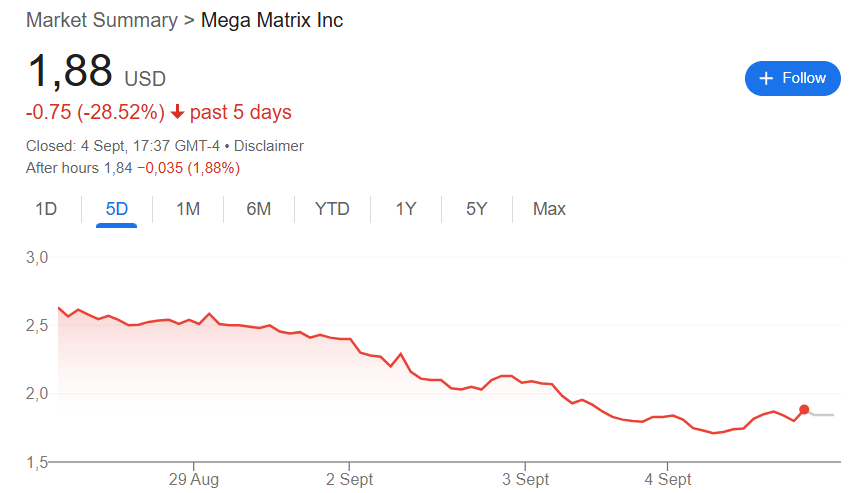Mega Matrix, a small-cap holding company trading on the NYSE under ticker MPU, has filed a $2 billion shelf registration with the Securities and Exchange Commission. The filing allows the company to raise funds for a digital asset treasury focused entirely on Ethena’s ENA governance token.
Mega Matrix Inc. (NYSE: MPU) filed a $2 billion universal shelf registration statement (Form F-3) to support its stablecoin governance token DAT strategy, aimed at accumulating tokens such as Ethena’s ENA. https://t.co/IJTPBfAFXE
— Wu Blockchain (@WuBlockchain) September 4, 2025
The registration represents an unusually large funding target for a company with just $113 million in market capitalization. Mega Matrix currently operates FlexTV, a short-form streaming platform, but reported first-quarter revenue of only $7.74 million with net losses of $2.48 million.
The company’s stock initially declined 6% following the announcement before recovering. Shares remain down nearly 30% since Mega Matrix first disclosed its cryptocurrency pivot on August 25.

Mega Matrix plans to accumulate ENA tokens rather than holding Ethena’s USDe stablecoin directly. The strategy aims to capture future revenue distributions through Ethena’s planned “fee-switch” mechanism, which would share protocol revenues with ENA token holders once activated.
ENA serves as the governance token for Ethena, the decentralized finance protocol behind USDe. The synthetic stablecoin maintains its $1 peg through a combination of spot cryptocurrency holdings and equal derivatives positions that hedge price risk.
This hedging mechanism allows Ethena to generate yield from funding rates in derivatives markets. The protocol has reported cumulative gross interest revenue exceeding $500 million through August.
USDe has grown rapidly to become the world’s third-largest stablecoin with a market capitalization of $12.5 billion. The token differs from traditional fiat-backed stablecoins like USDC and Tether’s USDT by using synthetic backing rather than direct dollar reserves.
Ethena’s growth partly stems from regulatory restrictions on traditional stablecoins. The US GENIUS Act prohibits stablecoin issuers from paying yield directly to holders, creating demand for yield-bearing alternatives like USDe.
Mega Matrix joins a growing number of publicly traded companies adopting digital asset treasury strategies. MicroStrategy pioneered this approach with bitcoin accumulation, while newer entrants have focused on smaller tokens and specialized protocols.
The company previously purchased $1.27 million worth of bitcoin in June as an initial step into cryptocurrency holdings. Other firms following similar paths include ETHZilla, which has accumulated hundreds of millions in Ether value, plus BitMine Immersion Technologies and SharpLink Gaming.
Another company called StablecoinX announced plans in July to go public through a SPAC merger with a similar ENA treasury focus. That deal targets completion by year-end.
However, the digital asset treasury sector has shown recent weakness. Several companies pursuing these strategies have seen stock prices decline 70-80% in recent months, with some trading below the net asset value of their cryptocurrency holdings.
Industry observers have raised concerns about the complexity and risks of these treasury models. Some compare them to collateralized debt obligations that contributed to the 2008 financial crisis, citing uncertainty about actual investor exposure.
Mega Matrix completed its $2 billion shelf registration filing on Thursday, providing the regulatory framework to proceed with future securities offerings to fund ENA token purchases.
The post Small-Cap Mega Matrix Bets Big on Ethena with $2 Billion Treasury Plan appeared first on CoinCentral.
Also read: 7-Types of Scaffolding in Building Construction